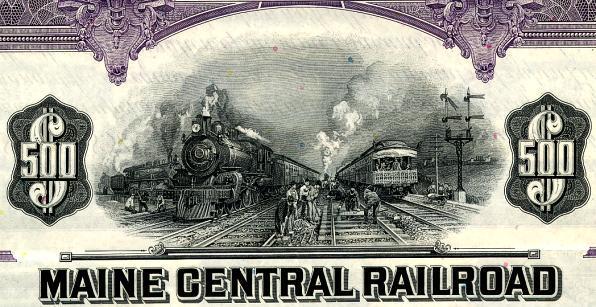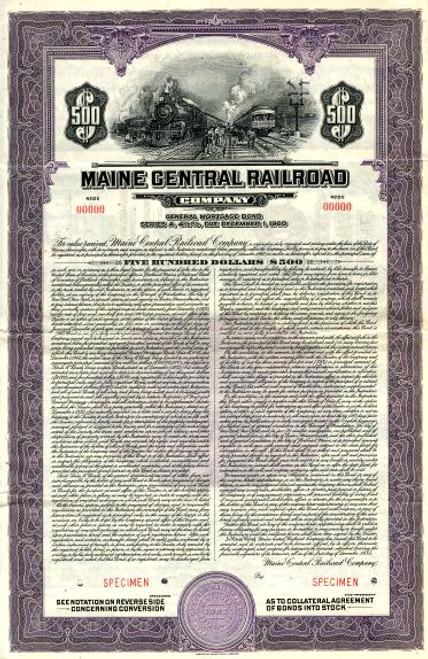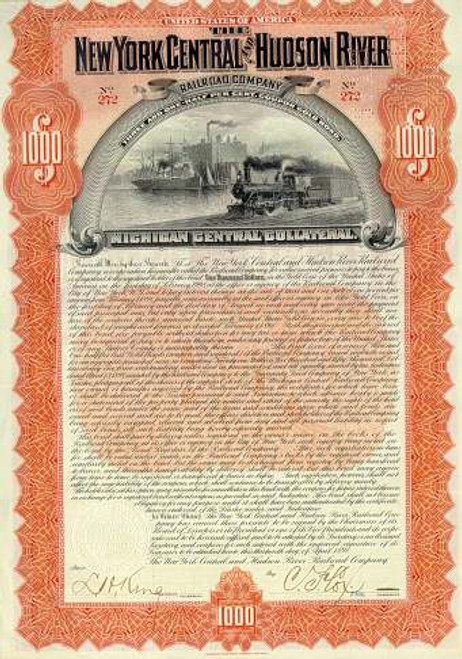Beautiful certificate from the Maine Central Railroad dated 1935. This historic document was printed by the American Banknote Company and has an ornate border around it with a vignette of two trains with workers between them. This item is over 71 years old. 50 coupons attached on right side. 
Certificate Vignette The Maine Central Railroad was a railroad in central and southern Maine. It was chartered in 1856 and began operations in 1862. It operated between South Portland, Maine east to the Canada-U.S. border with New Brunswick, west to Vermont and north to Quebec. The Maine Central RR was created initially through the merger of the Androscoggin and Kennebec Railroad and the Penobscot and Kennebec Railroad, resulting in a line from Danville (northeast of Portland) to Bangor. The line connected with the Grand Trunk Railway on its Portland-Chicago mainline at Danville and with the Bangor and Piscataquis Railroad in Bangor. As a result of its connection with the Grand Trunk, the Maine Central was initially running with a track gauge of 5 ft 6 in (1676 mm). The Maine Central purchased the Portland and Kennebec Railroad, which ran from Portland to Danville and was built to standard track gauge, since it connected with the Boston and Maine Railroad at Portland. By 1871, the Maine Central completed its conversion to standard gauge to facilitate interchange of cars. The MEC established rail service to the Penobscot Bay in 1871 by leasing (for fifty years) the then just-completed 33+ miles of track built by the Belfast and Moosehead Lake Railroad. The B&ML's grade ran the length of Waldo County from the port town of Belfast inland to Burnham Junction where its single track connected with the MEC's Portland to Bangor mainline. The Maine Central would operate the road as its "Belfast Branch" for the next 55 years, but on June 30, 1925, MEC President Morris McDonald -- after repeated public denials -- suddenly gave the B&ML (and the city of Belfast as its majority owner) the required six months notice that it would not renew its by then year-to-year lease when it expired on December 31, 1925. (The B&ML took over operation of its road on January 1, 1926, and continued to exchange passengers and mail with the MEC at their jointly owned station at Burnham Junction until 1960 and freight interchange traffic until 2002.) In 1882, the Maine Central leased the European and North American Railway (E&NA) between Bangor and Vanceboro. In 1888, the Maine Central purchased the Portland and Ogdensburg Railroad, which ran from Portland, through the White Mountains via Crawford Notch, New Hampshire, and into St. Johnsbury, Vermont, where it connected with the Southeastern Railway (owned by the Canadian Pacific Railway). The railroad also purchased several narrow-gauge branch lines used for the logging industry, such as the Sandy River and Rangeley Lakes Railroad in 1911 and the Bridgeton and Saco River in 1912. In 1889, the Canadian Pacific Railway purchased trackage rights from Maine Central on the portion of the former E&NA from Mattawamkeag to Vanceboro. This Maine Central trackage formed part of the CPR's Montreal-Saint John mainline, upon completion of the International Railway of Maine. This line was an important rail route for Canadian war materiel heading to the port of Saint John for shipment overseas to Europe. In the months before the United States entered the war, a German saboteur attempted to blow up the railway bridge which crossed the St. Croix River at the international boundary. The Maine Central also built a line southeast from Bangor along the coast through Machias to Calais, with branches to Bar Harbor and Eastport. The Maine Central was at its height by 1917 when it became nationalized during World War One, having trackage which extended over 1358 miles. It ran from Vanceboro, Calais and Eastport in the east, to Portland in the south, St. Johnsbury in the west, and to Lime Ridge, Quebec in the north. It also operated resorts and coastal steamships and ferries. MEC "pine tree" herald.Following World War One, Maine Central began retracting. It sold or abandoned lines such as the narrow gauge logging systems, as well as its ferries and steamships. In the 1930s it began to change its locomotives from steam powered to diesel powered. Beginning in 1933, the Maine Central entered into a "joint management" agreement with the Boston and Maine Railroad, with which it shared the Portland Terminal Railroad (a switching railroad in Portland). In 1955, Maine Central completed a purchase of the E&NA line from Bangor to Vanceboro which it had leased in 1882. The deal consisted of $125 per share or $3,114,500 payable in cash or bonds at the election of the E&NA shareholders. Faced with increased competition from cars, trucks and buses, Maine Central Railroad operated its last passenger train on September 5, 1960 and continued to reduce its freight business to reflect changing traffic. On December 17, 1974 Maine Central sold its trackage between Mattawamkeag and Vanceboro to Canadian Pacific for $5.4 million while retaining trackage rights from CPR over the section of line. In 1980, the railroad was purchased by U.S. Filter Corporation and was then sold in 1981 to Guilford Transportation Industries, which later purchased the Boston and Maine Railroad in 1983 and the Delaware and Hudson Railway in 1984. Initially Guilford operated the system intact, although the system now permitted run-through traffic between central Maine and Boston. By the mid-1980s, Guilford began to rationalize its system and fully one-third of Maine Central's trackage was eliminated, including: the "Mountain Division" from Portland to St. Johnsbury, Vermont; the "Rockland Branch" from Brunswick to Rockland, the "Calais Branch" from Bangor to Calais, and the "Lower Road" from Augusta to Brunswick. Guilford also forced many management and salary changes, resulting in a major strike against the company in 1986. Guilford Transportation Industries logo.One of the instigating factors which led to the labour strife at Guilford relates to a corporate reorganization at one of the company's former Maine Central properties. After the Calais Branch was abandoned, a small portion of trackage between Calais and Woodland remained in service to a pulp mill. It was joined to the rest of the North American rail network through a connection with the Canadian Pacific Railway at St. Stephen, New Brunswick and operated through New Brunswick territory for several miles between Calais and Woodland. Guilford renamed this operation Springfield Terminal and reorganized it to avoid union agreements that the rest of the rail system was forced to follow. Eventually, the corporate reorganization under Springfield Terminal would extend to the full extent of Guilford operations. The former Maine Central locomotive shops in Waterville continue as Guilford's main repair shops. Other traditions of Maine Central have continued into the 1990s and 2000s, although Guilford and its subsidiary Springfield Terminal now dominate in the painting of locomotives. On November 1, 2003 the Morristown & Erie Railway took over the former Maine Central "Lower Road" (main line) and Rockland Branch routes (aided by significant public funding from the state Department of Transportation). M&E is operating these state-owned lines as the Maine Eastern Railroad. Prior to M&E, the Rockland Branch had been operated by Safe Handling, and before that, the Maine Coast Railroad. Several railroad preservation and promotion groups are seeking to have the state-owned Calais Branch and Mountain Division routes reactivated for use by short line or tourist rail operations. The Guilford Rail System's Boston and Maine Railroad comes into the state of Maine in South Berwick, through the town's southwest corner, continuing northeast through North Berwick, Wells, Kennebunk, Arundel, Biddeford, Saco, Old Orchard Beach, and Scarborough before coming to Rigby Yard in South Portland. Rigby is the historic junction point for the end-to-end MEC and B&M systems. The MEC main line's western terminus is at Rigby and runs northeast through Portland, Falmouth, Cumberland, and Royal Junction (in Yarmouth). The "Back Road" main line continues northeast through North Yarmouth, New Gloucester, Auburn, Danville Jct., Lewiston, Leeds Jct., Readfield, Belgrade, Waterville, Pittsfield, Hermon, Northern Maine Jct., Bangor, Orono, Old Town, and ends at its eastern terminus at Mattawamkeag. GRS's Maine Central main line interchanges with the Eastern Maine Railway at Mattawamkeag, the Montreal, Maine and Atlantic Railway at Northern Maine Jct., and the St. Lawrence and Atlantic Railroad at Danville Jct. Maine Central under GRS has several branch lines still under Guilford ownership. The Brunswick branch splits off the mainline at Royal Junction and continues through the center of Yarmouth, before meeting the St. Lawrence and Atlantic Railroad (ex-Canadian National Railway, nee-Grand Trunk Railway) at Yarmouth Junction. The tracks meet at a 90 degree angle, and then the branch line continues through Freeport, where the line crosses under U.S. Route 1. After going through the center of Freeport, the line ends in Brunswick, where the eastern part of the line is now owned by the Maine Coast Railroad. The Rumford branch splits off the mainline at Leeds Junction and continues northwest up the Androscoggin River valley, passing through Livermore Falls, terminating at Rumford. The Bucksport branch splits off the mainline at Bangor and continues south down the Penobscot River valley, passing through Brewer and terminating at Bucksport. This 19-mile branch was chartered in 1870 as the Bucksport and Bangor Railroad and its grade was surveyed in the autumn of 1872. Construction of the line began in the spring of 1873 with trains beginning to run regularly over its whole length on December 21, 1874. The MEC took over operation of the branch from the European and North American Railway in 1883. The Calais branch is a short, isolated section of former MEC trackage at the far eastern edge of Maine, running from a pulp mill in Woodlands to the city of Calais. Once part of a much longer line that ran from Bangor to Calais, it has been cut back to the present trackage and for part of the way it runs through the neighbouring province of New Brunswick, Canada where it interchanges with the New Brunswick Southern Railway. History from Wikipeida and OldCompanyResearch.com.

Certificate Vignette










